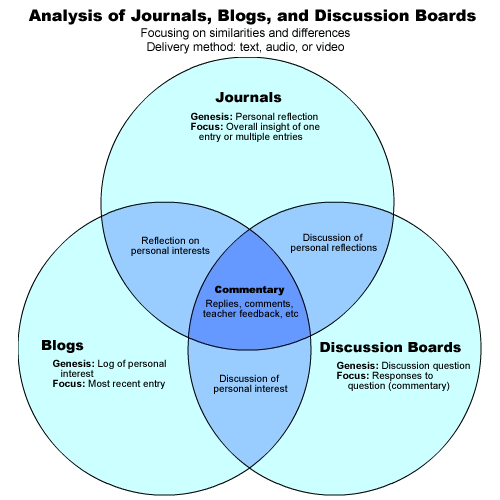The Confusion Over a Little Thing Called Blog
(published in the former MoodleZine Online Journal, July 2006)
Blogs are one of the current hot topics in educational technology. That will probably change by this time next year, but for now many of us are grappling to understand how reverse chronological reflection journals with feedback can fit into our educational theologies. Even worse – many of us are confused as to just how web logs are so different from online journals or even discussion boards. We understand those two – but what about this new kid on the block?The answer to this confusion is actually a very simple one. When it comes down to it, blogs, journals, and discussion boards are all forms of personal publication that have the exact same core components:
- Genesis – something prods the publication into existence. This prod may be the need to reflect on personal issues, or the need to start an online conversation.
- Input – there is always a place to type in what you want to say, and then fearlessly press “Submit.” Well, what you have to say may cause you to sweat that pressing some, but we still all end up doing it any way. Any type of media can be submitted – text, audio, or video.
- Interface – The submission is viewed through an interface. This may resemble a typical web log, or a threaded discussion, or any number of configurations.
- Feedback – sometimes a function for the truly brave (or the gluttons for punishment), there always seems to be a way to hear back from the audience. Whether it is just getting responses from the instructor or arguments from strangers around the world – there is almost always an opening for something.
So, why do we tend to see blogs, journals, and discussion boards as totally separate, and sometimes totally incompatible, entities? Because each one of them has a totally different focus. And that focus determines how all of the above listed components end up functioning.
For blogs, the focus is on the most recent input in a string of inputs. This means that the interface is going to display the entries chronologically. This also means that the input device is going to allow for several entries. The feedback mechanism usually will only allow for comments on that input, and related discussions will usually be confusing to follow because of that.
For journals, the focus is on the overall insight of the entry (or entries). This means that the teacher is usually the only one to be able to return feedback. Many times, the input and interface features are minimal or even non-existent (“just e-mail me a Word doc”), even though they can be well-developed at times.
For discussion boards, the focus is on the feedback to the initial question or comment (the genesis). This means that the interface will focus on how to display these responses in an easy to read format. Some discussion board programs obviously don’t spend very much time on developing this, but at least they know they should.
So these all sound similar. Why does it all get confusing? Because human beings are so hung up on words. If a college professor is fiercely anti-blog, he or she won’t touch a function named “blog” with a 10 foot USB cable. But they will come to an instructional designer demanding to have a personal journal activity for students to complete, and describe it just like a blog. Sometimes you can’t win.
Blogs are being added as a new feature in Moodle version 1.6. Of course, some users will blow them off and never touch them, and others will proclaim that they have been using journal or discussion functions for blogging for years (even if they only installed Moodle last semester). So it may not seem so “new” to some. At least 1.6 will bring all of the players in the online publishing game to the table with 1.6 – something that many other LMS/CMS applications have yet to accomplish.
Maybe someday in Moodle we will see a combined function – for example, something called “iPublish” – that allows the teacher to choose the name of the publication – blog, journal, or discussion board. Then, Moodle will assemble the interface to resemble the typical construction of the chosen medium (and create RSS feeds for podcasts, vodcasts, etc if needed).
Separating the content of the medium from the focus of the medium could have two distinct benefits. One is flexibility. Is that great blog idea you had turning into an intense discussion? Change one setting and it now looks like one. Are your students confused over this ancient word “journal” you use? Switch the setting and you will have them praising your cool use of a blog in no time.
The other benefit is simplicity. There will be less stuff for teachers to dig through (and a smaller database), but with the added benefit of letting anybody use what ever word they are hung up on. And that’s just what the education world needs today – less hang-ups.
Matt Crosslin, M.Ed.
Instructional Designer
University of Texas at Arlington
